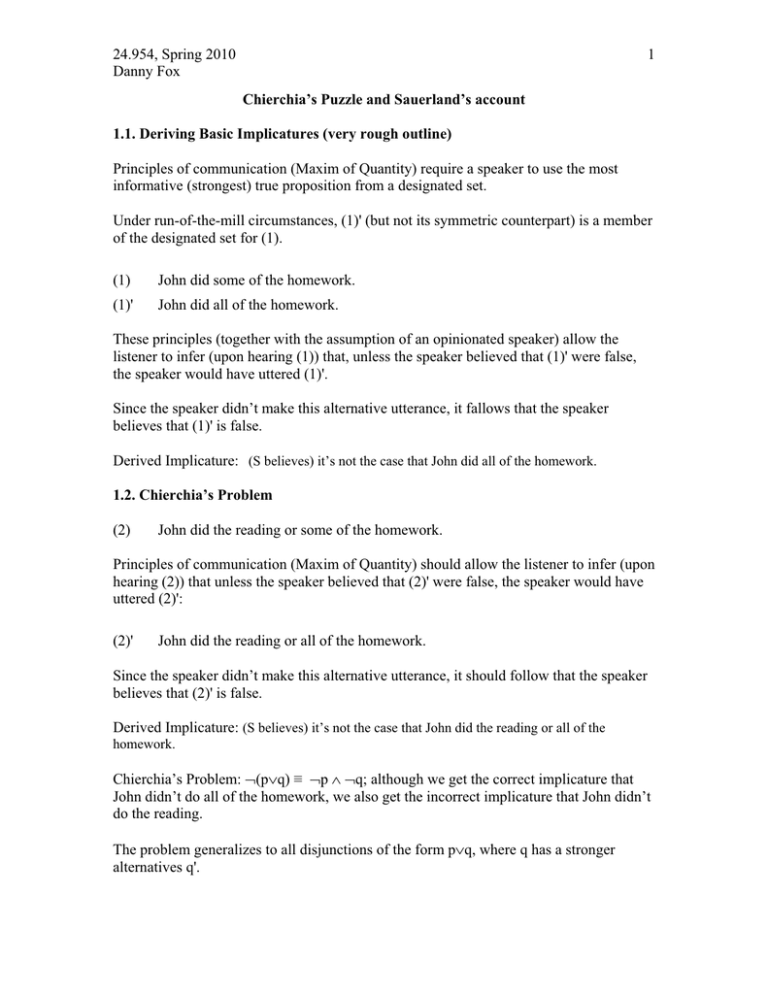1 24.954, Spring 2010 Danny Fox
advertisement

24.954, Spring 2010
Danny Fox
1
Chierchia’s Puzzle and Sauerland’s account
1.1. Deriving Basic Implicatures (very rough outline)
Principles of communication (Maxim of Quantity) require a speaker to use the most
informative (strongest) true proposition from a designated set.
Under run-of-the-mill circumstances, (1)' (but not its symmetric counterpart) is a member
of the designated set for (1).
(1)
John did some of the homework.
(1)'
John did all of the homework.
These principles (together with the assumption of an opinionated speaker) allow the
listener to infer (upon hearing (1)) that, unless the speaker believed that (1)' were false,
the speaker would have uttered (1)'.
Since the speaker didn’t make this alternative utterance, it fallows that the speaker
believes that (1)' is false.
Derived Implicature: (S believes) it’s not the case that John did all of the homework.
1.2. Chierchia’s Problem
(2)
John did the reading or some of the homework.
Principles of communication (Maxim of Quantity) should allow the listener to infer (upon
hearing (2)) that unless the speaker believed that (2)' were false, the speaker would have
uttered (2)':
(2)'
John did the reading or all of the homework.
Since the speaker didn’t make this alternative utterance, it should follow that the speaker
believes that (2)' is false.
Derived Implicature: (S believes) it’s not the case that John did the reading or all of the
homework.
Chierchia’s Problem: �(p�q) � �p � �q; although we get the correct implicature that
John didn’t do all of the homework, we also get the incorrect implicature that John didn’t
do the reading.
The problem generalizes to all disjunctions of the form p�q, where q has a stronger
alternatives q'.
24.954, Spring 2010
Danny Fox
2
More neutrally, we can say that the problem indicates that our generalization which was
stated as a desideratum for a theory of scalar implicatures was incorrect:
(3) The Exhaustivity Generalization (EG): utterance of a sentence, S, as a default,
licenses the inference that (the speaker believes that) all of the scalar alternatives of S
that are logically stronger than S are false (Henceforth, the Exhaustivity Inference).
The Scalar Alternatives of a sentence S, Alt(S), are the set of sentences that can be
derived from S by replacing scalar items in S by their scale-mates.
When q' is stronger than q, p�q' is stronger than p�q. Furthermore, if q'�Alt(q),
p�q'�Alt(p�q). Yet, contrary to EG an utterance of p�q does not lead to the inference
that p�q' is false.
Chierchia’s Generalization: The (pragmatically) strengthened meaning of a disjunctive sentence, � � �, is the following: S(� � �) = [S(�) � � �] or [S(�) � ��] 4.3. Sauerland’s Proposal1
1. Enrich the set of alternatives for disjunction:
(4) Horn-Scale(or) = {or, L, R, and} (pLq = p; pRq = q)
p
(5) Alt(p�q)= p�q
p�q
q
2. An algorithm for computing scalar implicatures:
A. Form the set of Primary (weak) Implicatures:
PI = {�Bs(A'): A'� ALT(A) and A' is stronger than A}
B.
Form the set of Secondary (strong) Implicatures:
SI = {Bs(�A'): A'� ALT(A), A' is stronger than A, and
Bs(A) � �PI � Bs(�A') is not contradictory}
Set A is the set of inferences that we derive directly from the (assumption that the speaker
obeys the) Maxim of Quantity.
Set B is the set of inferences that stronger alternatives are false, which are introduced
whenever it is possible to assume that the speaker is opinionated about stronger
1
Benjamin Spector (2005, 2007) made the same proposal, in a somewhat different (more generalized)
format. A related proposal can be found in Yae-Sheik Lee (1995).
24.954, Spring 2010
Danny Fox
3
alternative; whenever the assumption of an opinionated speaker is consistent with what
has already been inferred from the maxim of quantity.
When a simple disjunctive sentence, p�q, is uttered, we derive the following:
PI = �Bs(p), �Bs(q), �Bs(p�q) SI = Bs� (p�q) The disjunction puzzle arises from embedding a non-maximal scalar item under
disjunction (P � Q where Q'�Alt(Q) and Q' is stronger than Q). The challenge is:
1. To avoid the implicature �(P � Q').
2. To derive the implicature � Q'
Challenge 1 is met in the following way: �Bs(Q) is a primary implicatures and
Bs(P� Q) � �Bs(Q) � Bs(�(P � Q')) is contradictory.
Challenge 2 is met straightforwardly: given (4), Q'� Alt (P � Q), and the Secondary
Implicature Bs(� Q') is consistent with the assertion and the primary implicatures.
In detail
(6) Kai ate some of the soup or the broccoli,
ALT(6) =
b
as�b
ss�b
as�b
as
ss�b ss
Bs(ss�b) PI = �Bs(as�b), �Bs(ss),
SI = Bs(�as), Bs(�(ss�b))
(the rest follow)
(the rest [Bs(�(as�b))] follows) 24.954, Spring 2010
Danny Fox
4
4.4. Advantage of Sauerland’s Proposal: embedding under universal quantifiers
(7) You’re required to talk to Mary or Sue.
Implicatures:
a. You’re not required to talk to Mary.
b. You’re not required to talk to Sue.
(8) Every friend of mine has a boy friend or a girl friend.
a. It’s not true that every friend of mine has a boy friend.
b. It’s not true that every friend of mine has a girl friend.
These facts follow straightforwardly from the Sauerland scale:
(9) Alt(�x(P(x)�Q(x))= �x(P(x)�Q(x))
PI = �Bs(�xP(x)), �Bs(�xQ(x))
SI = Bs(��xP(x)), Bs(��xQ(x))
�xP(x)
�xQ(x)
�x(P(x)�Q(x))
(the rest follows)
(the rest follows)
4.5. The Predicted Generalization
(10) The S-Exhaustivity Generalization (predicted by Sauerland’s Theory): utterance
of a sentence, S, as a default, licenses the inference that (the speaker believes that)
every sentence is false if it is Sauerland-Excludable given S and Alt(S).
p is Sauerland-Excludable given S and C if p�C, p is stronger than S and ��q�C [(q is stronger than S) and (S��p entails q)]. Homework:
1. Prove that the S-Exhaustivity Generalization is indeed predicted by Sauerland’s
theory.
2. Come up with a set of sentences C and a sentence S such that the set {�p: p is
Sauerland-Excludable alternatives of S given C} is inconsistent with S.
Can you think of possible implications of this exercise?
24.954, Spring 2010
Danny Fox
5
Remaining Cracks in the neo-Gricean System
1. Hurford Disjunctions
(11) John talked to Mary or Sue or both
p
Alt(12)= (p � q)
p�q
q
Equivalences:
(p � q) � (p � q) = (p � q) L (p � q) = …= (p � q)
(p L q) � (p � q) = p � (p � q) = (p L q) L (p �/�/L q) = …= p
(p R q) � (p � q) = q � (p � q) = (p R q) L (p �/�/L q) = …= q
(p L/R/� q) � (p � q) = … = p � q
Key point: we would get the right results if the first disjunct were interpreted
exclusively. Homework: to understand why.
2. Free Choice
(12) You may eat the cake or the ice-cream.
Inferences: a. You may eat the cake.
b. You
may eat the ice-cream.
c. Maybe: You’re not allowed to eat the cake and the ice-cream.
Wide scope for allowed, i.e., there is no allowed world in which you do both.
We’ve seen good arguments that FC should be derived as an implicature. However, under
Sauerland’s system we derive primary implicatures that contradict FC:
Alt(12)= �(p � q)
�p
�q
�(p�q)
We incorrectly derive:
PI = �Bs(�p), �Bs(�q), �Bs�(p�q) SI = Bs� �(p�q) 24.954, Spring 2010 Danny Fox 6
Key point: we would get the right results if each of the alternative were interpreted with a strengthened meaning: �(p � q) � �(p � q) � ��(p � q) �(p) � �(p) � ��(q) �(p) � �(q) � ��(p) �(p � q) � �(p � q) Homework: to understand why! 3. Comparatives and modified numerals
(13)
a. John has more than 3 children.
b. John has 4 or more children.
c. John has at least 4 children.
d. John has 4 children.
(Krifka 1999)
See Fox and Hackl (2006), Fox (2007), Geurts and Nouwen (2007), Nouwen (2008),
Spector (2005).
4. Evidence for Embedded Implicatures
(14)
The man who is talking to Mary or Sue is my brother.
The man who is talking to Mary and Sue is my brother in law.
(Levison 2000)
(15)
Some people met Mary or Sue. (Chierchia 2004)
(16) Some people who know linguistics or philosophy came to the party.
(Eliza Block, 2007 handout)
And many more: Cohen 1971, Kempson 197x, Chierchia 2004, passim
5. Modularity
(17) #John has an even number of children. More specifically, he has 3 children.
(Fox 2004, class notes)
See also Heim 1991, Magri 2007, Fox and Hackl 2006.
6. Cumulative Interpretation (Krifka 1998, Landman 2000)
(18)
3 boys ate 7 apples.
24.954, Spring 2010
Danny Fox
Scha claims that the sentence is false if 4 boys ate 8 apples (cumulatively; henceforth 4
boys cum-ate 8 apples).
Krifka and Landman argue that this is an implicature:
(19)
3 boys ate 7 apples. And, it is even possible that 4 boys ate 8 apples.
But how could we derive the implicature. After all, 4 boys ate 8 apples is not more
informative than 3 boys ate 7 apples.
7. Other Cracks
� Implicature accounts of the DE constraint on NPIs: accounts NPI licensing in
terms of systematic contradictions derived by an implicature-generating device
(Krifka, Chierchia).
� Intervention Effects: interactions between implicature and NPI licensing,
intervention effects (Chierchia 2004, 2005) � Free Choice items and their distribution (Chierchia 2006)
7
24.954, Spring 2010
Danny Fox
8
An alternative perspective (cf. G&S 1984; Krifka 1995)
Suppose we derived scalar implicatures within grammar. We might then expect
embedded implicatures. We will see that it can also help us fill in the other cracks in the
Gricean picture. But first some technical work.
1. Background: the semantics of only and association with focus
(20) a. Mary only introduced JOHN to Sue.
b. Mary only introduced John to SUE.
b. Mary only introduced JOHN to SUE.
LFa: only [C][VP Mary introduced JohnF to Sue]
LFb: only [C][VP Mary introduced John to SueF]
LFc: only [C][VP Mary introduced JohnF to SueF]
What the sentences in (20)) say is that among the propositions in the set C, the only
proposition that is true is the proposition that Mary introduced John to Sue. The sentences
differ in the value of C something that needs to follow from the theory of focus (For
discussion see Rooth (1995), Beaver and Clark (2003)).
(21)
a .
b.
c.
C(20)a) = {pst: �x�De and p = �w. Mary introduced x to Sue in w}.
C(20)a) = {pst: �x�De and p = �w. Mary introduced John to x in w}.
C(20)a) = {pst: �x,y�De and p = �w. Mary introduced x to y in w}.
(22) C is (a subset of) the focus value of VP (Foc(VP)).
(23) Informally: Foc(VP) is the set of propositions that can be derived from the
interpretations of various modifications of VP; modifications in which focused
constituents are replaced by various alternatives.
(24) [[only]] = �C<st,t>.�pst.�w: p(w) =1. �q�C. (q(w) =1) � (q = p)
How do we insure that C is (a subset of) the focus value of VP?
(25) Two general approaches:
a. C is directly constrained.
b. C is required to be a contextually relevant set and focus is correlated with the
context in the required way.
2. A modification in the semantics of only
(26) a. John only talked to [Bill and Mary]F.
b. #That’s not true. Look, he talked to BILL.
b. John only read THREE books.
24.954, Spring 2010
Danny Fox
9
#That’s not true. Look, he read two books.
(27) [[only]] = �C<st,t>.�pst.�w: p(w) =1. �q�C. (q(w) =1) � (p � q)
(28) The alternatives of Scalar items are their scale-mates.
Consequence of this observation: the focus value of a sentence, S, in which the set
of focused constituents is the set of scalar items in S is Alt(S)
(29) a. John only read THREE books. He didn’t read FOUR.
b. John only read SOME books. He didn’t read ALL books.
a. John only talked to Mary OR Sue. He didn’t talk to Mary AND Sue.
3. The Postulation of a null exhaustivity operator2
(30) Speaker A: Look at these 10 boys. Which of them do you know?
Speaker B: I know John and Bill.
Inference: B doesn’t know any of the other boys.
(31) EXH(C)[I know [John and Bill]F]
(32) [[EXH]] = �C<st,t>.�pst.�w. p(w) =1 and �q�C. (q(w) =1) � (p � q)
4. The Exhaustivity Generalization (from class 1-3)
(33) The Exhaustivity Generalization: utterance of a sentence, S, licenses, as a default,
the inference that (the speaker believes that) all of the scalar alternatives of S that
are logically stronger than S are false.
The Scalar Alternatives of a sentence S, Alt(S), are the set of sentences that can
be derived from S by replacing scalar items in S by their scale-mates.
This generalization would seem to follow if, as-default, sentences are interpreted as
answers to questions and the following stipulation holds:3
(34)
Stipulation:
1. Scalar items are inherently focused.4 Or alternatively
2. Alt(S) is most times contextually given
2
Groenendijk, J. and M. Stokhof (1984). Studies on the Semantics of Questions and the Pragmatics of Answers, University of Amsterdam. Our exhaustivity operator is taken from Krifka (1995) and is different from that of G&S. See also Fintel, K. v. (1997). “Bare Plurals, Bare Conditionals, and Only.” Journal of Semantics 14: 1-56. We will see that some more work is needed to replicate Sauerland’s account. 3
In the end, the generalization will turn out to be false. Instead the OIG will be true. 4
See Krifka (1995) for a particular implementation of the stipulation.
24.954, Spring 2010
Danny Fox
10
(the latter is essentially the Gricean stipulation)
(35))
I have three children.
default structure: EXH(C)[S I have threeF children].
[[(35))]] = 1 iff I have (at least) 3 children and every proposition in C that is true is
entailed by the proposition that I have (at least) 3 children.
iff I have (at least) 3 children and every proposition in Alt(S) that is true is
entailed by the proposition that I have (at least) 3 children.
Hope: We don’t need a stipulation. The Exhaustivity Generalization holds only when
the scalar item is focused which is often enough the case.
Welker (1994):
(36)
a. I need four chairs.
b. JOHN has four chairs.
(37)
a. I need four chairs.
b. John has TWO chairs.
Possible Conclusions:
1. If there is no focus on the scalar word, we don’t get the implicature.
2. If the context makes a different set of propositions salient, we don’t get the
implicature (or rather we get a different implicature).
The New Ambiguity Hypothesis: All sentences are systematically ambiguous. The
source of this ambiguity is an optional exhaustivity operator.
Chierchia’s Pragmatic Principle (cf. Dalrymple et. al 1994, 1998): When a sentence is
ambiguous the default interpretation is the strongest alternative.
Another possible alternative: Exh operator is totally optional. However, if it is not
present, there will be an implicature that the speaker is ignorant about every stronger
alternative. In most contexts the implicature is implausible, hence the exh is preferred.
(Fox 2006)
5. Back to Stephenson’s Objection
(38)
John has 2 children. Bill does, too. In fact, Bill has 3 children.
24.954, Spring 2010
Danny Fox
11
This is no longer predicted to be bad. The VP meaning of the first sentence in (38)) is the
same whether or not there is an exhaustive operator above.
(39)
A: Who did you say John talked to?
B: I only said that he talked to MaryF.
A: Do you think Bill did <talk to Mary>?
B: I think he did <talk to Mary>. But I think that Bill talked to Sue as well.
6. Which is Simpler?
I think it’s still hard to tell.
Assumptions of the neo-Gricean account: a. Alt(S) is the relevant set of alternatives.
b. Hearer’s assume that speakers are opinionated about the truth value of the members
of Alt(S).
Assumptions of the syntactic alternative:
a. Alt(S) is the relevant set of alternatives.
b. Covert Exh is a lexical entry.
c. Strongest meaning hypothesis, or one of the alternativs suggested.
7. Back to the “cracks in the Gricean picture”
MIT OpenCourseWare
http://ocw.mit.edu
24.954 Pragmatics in Linguistic Theory
Spring 2010
For information about citing these materials or our Terms of Use, visit: http://ocw.mit.edu/terms.



